So far I have posted the DESIGN AND BUILD, BACKYARD TRELLIS, TIRE PORTION OF THE GARDEN, AND BRASSICAS. This post will be about the orchard.
When I'd decided to construct this garden a key element that was really important to me was having fruit trees. Because of the climate, citrus trees were popular and easy to find almost everywhere fruit trees were sold. The reason I opted to put these in pots rather than straight in the ground was that the yard was in pretty poor condition, power lines, water pipes, and gophers in the ground made me unsure where to put them. Growing them in containers made it easier to control their growth, as well as keep them closer to the house and watered without much effort or running hoses all over the yard.
LET'S BEGIN, SHALL WE?...
GENERAL LAYOUT
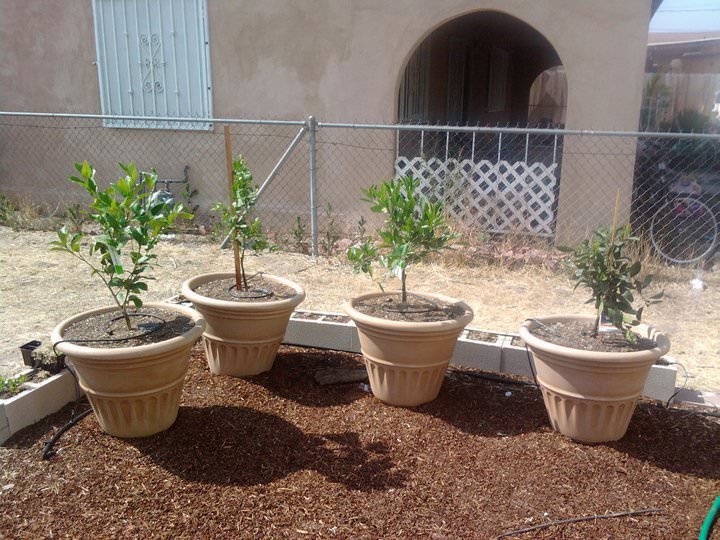
The trees were all dwarf varieties. They were all supposed to get 8-12 feet tall and wide when fully matured. There was a peach (not visible in this picture), lemon, key lime, tangelo, and mandarin. They were all put in 24" diameter pots with the store bought potting mix. Eventually, they were covered with about an inch of rubber mulch given to me by the neighbor.
This picture was taken soon after the trees were potted and soaker hose connected to the irrigation system. They were two year old plants at the time and were expected to be in full production within 3-5 years. They were quite healthy looking when they were planted, as you can see.

This picture was taken a month or so after being planted, still looking healthy. However, the Lemon and Tangelo were beginning to get some yellowing leaves. In this picture, there are some lemons already on the tree. There were beginning to be problems, unfortunately. That prompted me to ask around (many of my coworkers were growing citrus) and do research online, which I should have done before planting.
The problems were an unattractive and non-edible mushroom cropping up in all the planters. Earwigs were rampant throughout the entire garden, but they especially liked living under the rubber mulch during the day, coming out at night to feast. Earwigs are a type of beetle which have strong pinching jaws. You do not want to step on them, that's for sure. The leaves on the trees began to curl, dry out, and yellow. Eventually, there was quite a bit of flower and leaf drop on all of the trees.
The reason these problems occurred had to do with overwatering. Fungus thrives in overly moist soil. The fungus came from the bagged potting soil purchased at home depot which had mushroom compost in the mix. While it was not specifically harming the trees by growing, it was an early indication of overwatering. Earwigs love damp soil with daytime cover from the heat. They love munching on fresh growth, at least as far as my plants were concerned. The heaviest damage from the Earwigs was on the peach tree.
The flower and leaf drop was harder for me to diagnose because it seemed a few things could have caused it. Plus, the leaves were drying out. Once it was obvious the other problems were from overwatering, that seemed the most logical assumption. In the end, changing the irrigation system to only water once for 5 minutes, once a week, corrected the problem, but not before irreparable damage to the lemon tree. It was a goner.
LATE SPRING, MID SUMMER, LATE SUMMER PROGRESSION

This was when the trees really started stressing. It took a while to figure it out partially because I assumed early on it was just transplant shock, even though I had used a root starting liquid at the time of planting. The mandarin and tangelo were least affected. Here you can see the yellow keylime fruit/leaves and the lemon looking sickly. This picture was before the bulk of the leaf drop. In the back, the peach trees leaves were also beginning to yellow and drop leaves. This was somewhat because of overwatering, but mostly because of the damage from the earwigs.
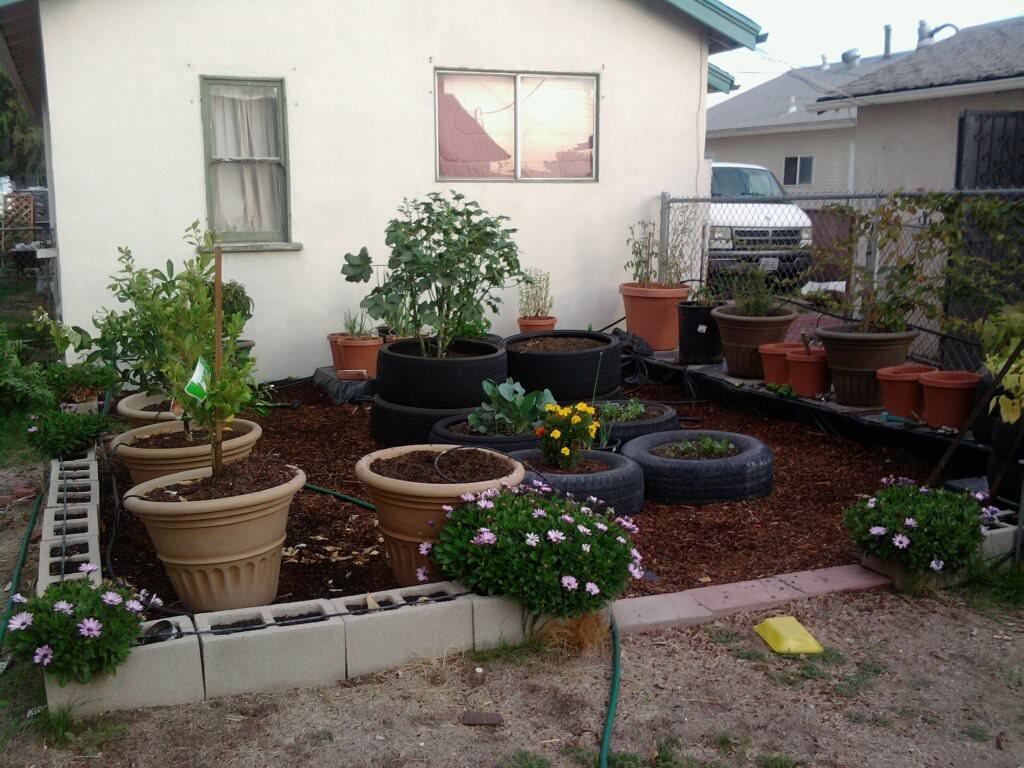
Here the trees look much better. The leaves had greened up again. The keylime looked a lot more defoliated but was revived. Another thing I did, besides reducing the number of times and days of watering, was using a zinc spray. This was a nutritional deficiency because the soil was poor, devoid of the micronutrients needed.
This is a nice overall view of the entire garden. The brassicas were beginning to grow and blackberries starting to be trained against the chainlink fence. The okra was beginning to bush out and flower. There were white Alyssum flowers planted in the empty spaces of the cinder blocks. None of them grew. I think those were actually being underwatered due to evaporation from the cinderblocks.
DWARF KEY LIME
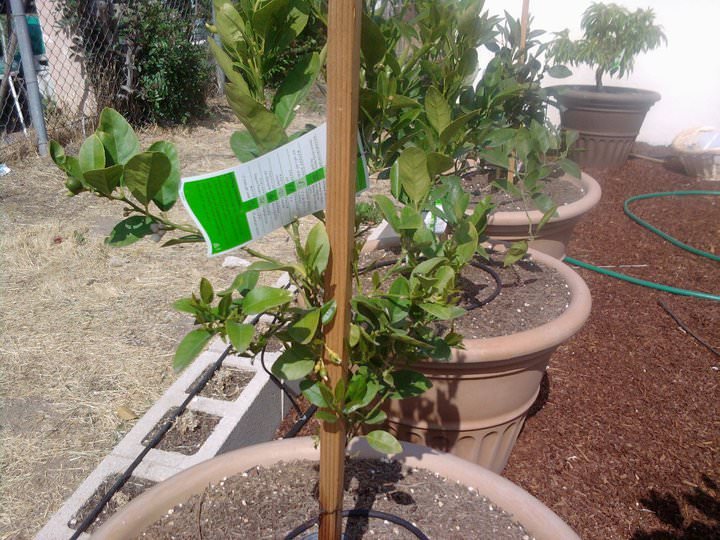
Close up of the Keylime before the rubber mulch was added and at the very beginning of the leaves yellowing. There are a couple of keylimes visible in the photo if you look closely.

The Keylime sure did have a lot of flowers. It's a shame it took so long to figure out the yellowing leaves. The majority of them dropped, leaving yellowing keylime fruit which dropped next, finally followed by the leaves. It's great that the tree was able to recover, but with the number of flowers, it would have been a heavy producer, at a much earlier date than the plant was supposed to be producing, as this was not even a 3 year old plant yet. This might have been because the neighbor had a lime tree nearby. While the dwarf trees were all self-pollinating, many self-pollinating trees do better when they are cross-pollinated by a different species within the same class.
DWARF MANDARIN
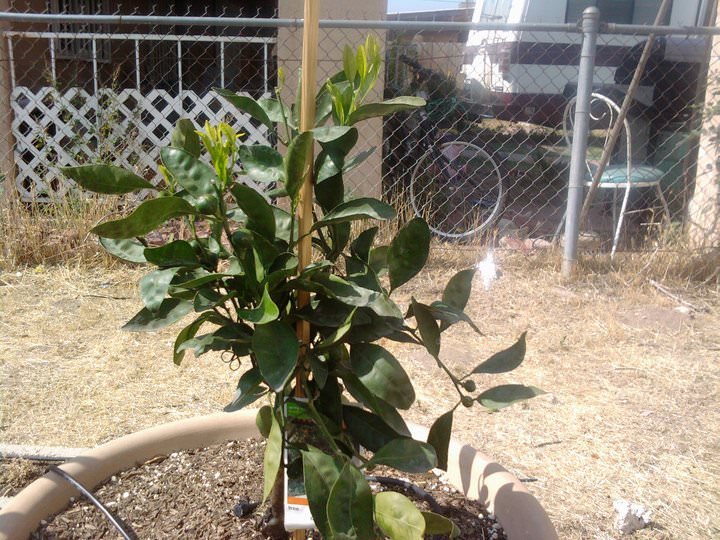
The dwarf Mandarin was the tree that suffered the least. You can see new growth at the top of the plant. It was the tree that had the least flowers and produced the fewest number of fruit. Most of them fell off. I mean, none of these trees were supposed to be producing until at least 3 years AFTER being planted, anyway. I was happy to see new growth, not expecting any fruit. There are a few fruit on the branches, though.

There are leaves with a white film because I had sprayed with a dehydrated milk, soap, and oil mix to try to combat the earwigs and fungus. That was only temporary because I'd not figured out yet the underlying problem was from overwatering. Citrus does not like to be watered too much.
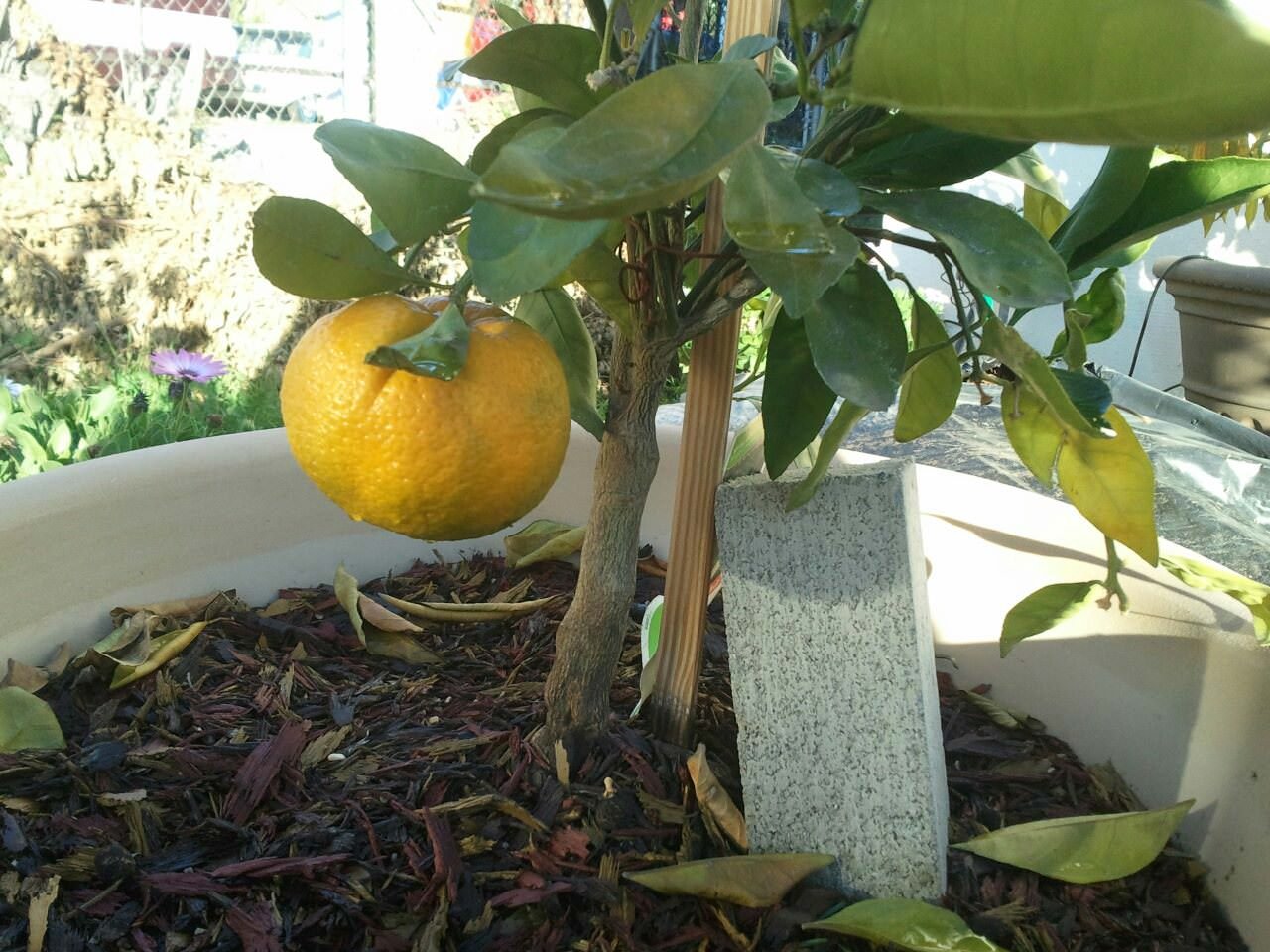
This first year, only this one mandarin was harvested. This was a pretty large one, about 3 inches in diameter. I was trying to leave it on the tree to turn completely orange but went ahead and picked it because I was tired of waiting and figured the tree was putting all of it's energy into that one fruit. Picking it did, in fact, stimulate more growth. It didn't taste good because it wasn't fully ripe. It made good compost food, though. Yes, I composted my citrus. Not sure why some people think that's a no-no.
DWARF TANGELO

Lots of flowers, several fruit, despite the flower and leaf drop. The Tangelo looked stressed but was the biggest success this first year. Did I mention already that the blooming flowers smelled sweet and delightful? In the left of the picture is a tangelo fruit which had a little yellowing on it and is much bigger than the other fruit. It was about 3 inches in diameter while the others you see in the picture were about the size of a half dollar.

Here is another one beginning to ripen. It was about 2 inches in diameter but seemed to take forever to ripen. It was second biggest of the group. It was picked before ripening so also made it to the compost bin.
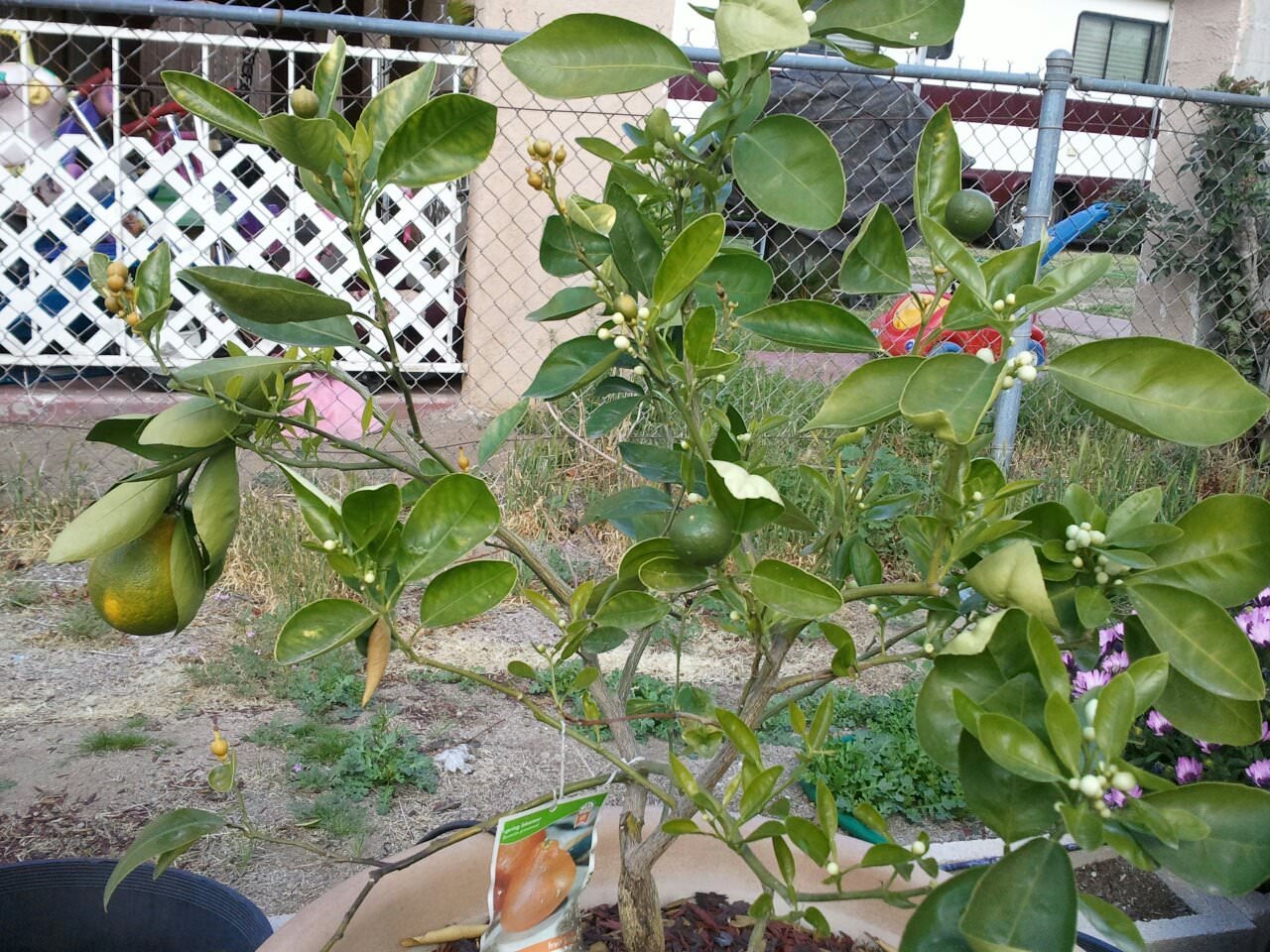
You can't see the fruit in the previous picture here as it was cutoff in the picture, but you can see the one in the first picture. This one got rather large for a tangelo. It ended up being close to 5 inches in diameter when it was finally picked. The other ones in the picture were starting to get bigger, but very slowly. Many flowers were still blooming on the tree but the majority of them dropped. Most of the fruit that started from them turned yellow and fell.

Quite a big of leaf drop on the tangelo at this point and many of those small fruits in the previous pictures didn't make it. That big one held on, though. In the background are the beautiful and happy Brussel Sprouts and Kohlrabi. The spent Okra was left in place as I thought the Fava Beans planted there were the vining type. They hadn't sprouted yet.
In the background on the left, you can see the bare peach tree. I was concerned that with all of the leaves having dropped that meant it was a goner too, like the lemon tree. It was actually because the damage from the earwigs caused the tree to temporarily go dormant then come out of dormancy before it was supposed to. The climate played a role in this probably. Later in the fall when the temperature dropped into the 50s the leaves fell once again, putting the peach in true dormancy.
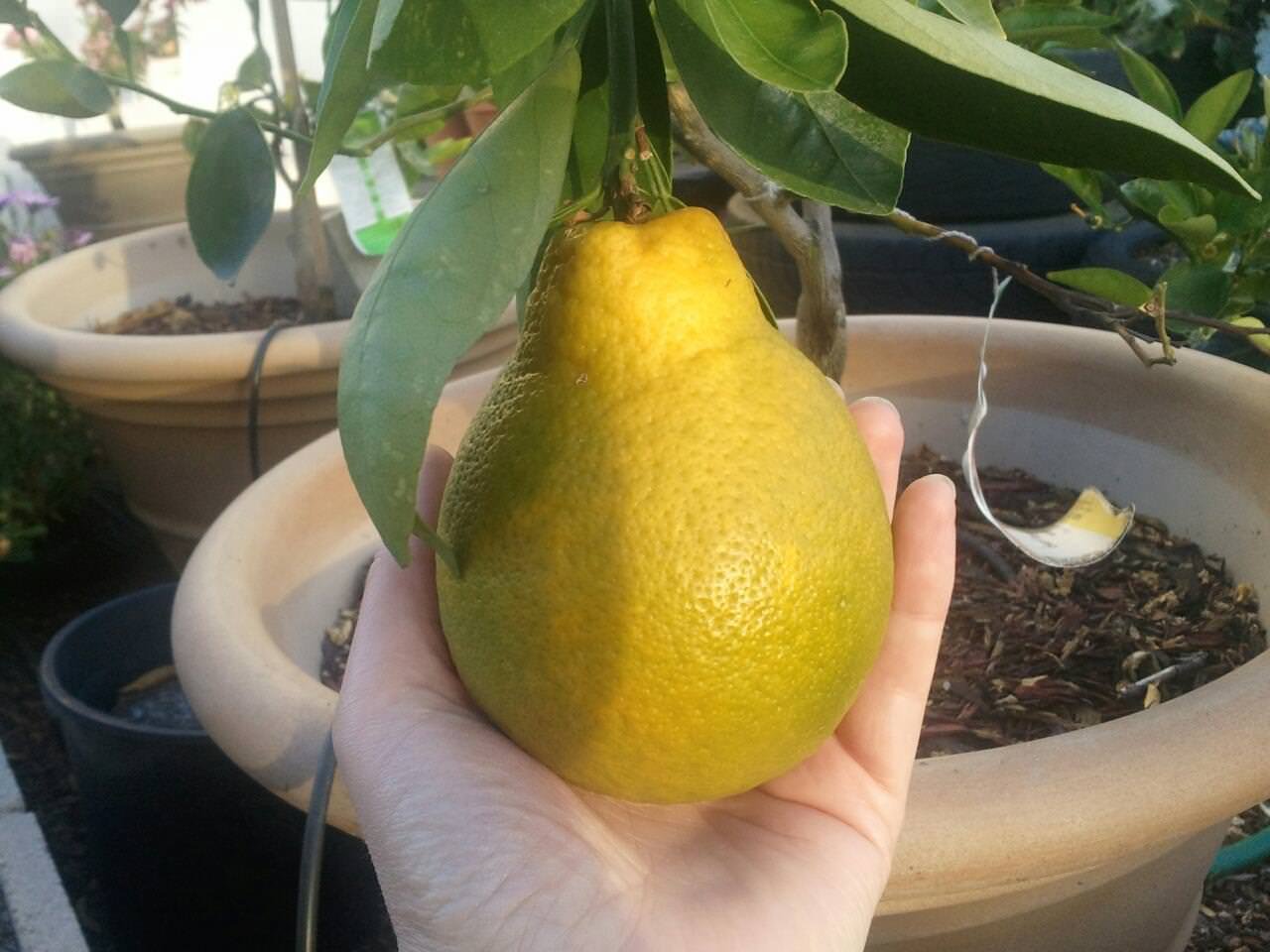
This picture was after the corrective measures revived the trees. This was the only tangelo that remained. It reached full size. Actually, it was slightly bigger than the ones being sold in the store. It took months and months of this fruit just slightly changing color, growing larger and larger. I became impatient so picked it a little bigger than this.
DWARF PEACH
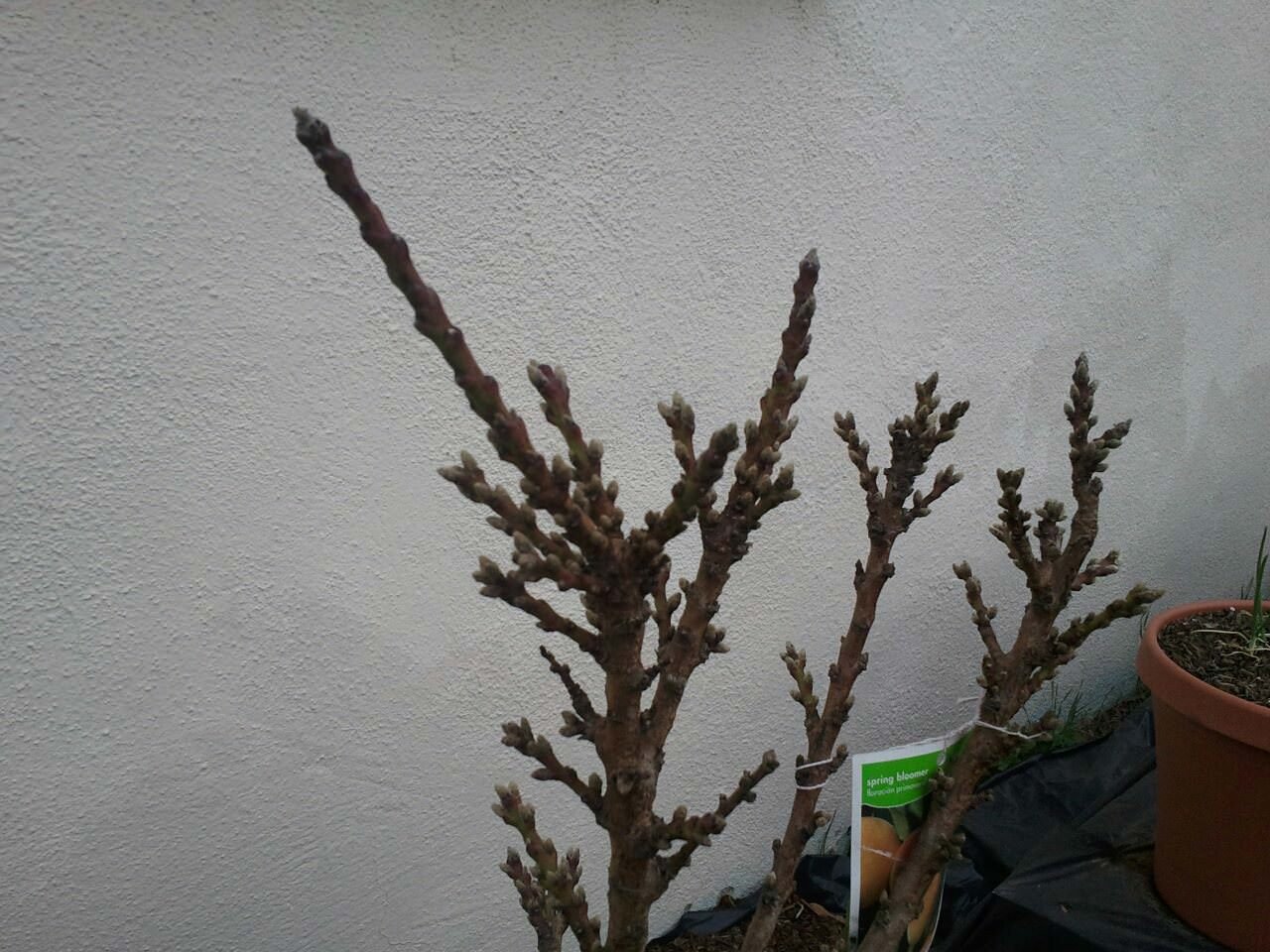
Flower buds forming on the peach after all of the leaves fell from the earwig damage. Although I didn't understand it, I was thrilled because this was a sign the tree was not dead after all.

I had no idea how beautiful the flowers on the peach would be, nor did I know the buds and flowers were the first to show up on the tree. I'd assumed the leaves would show up first like on the citrus. There sure was a lot I was naive about.
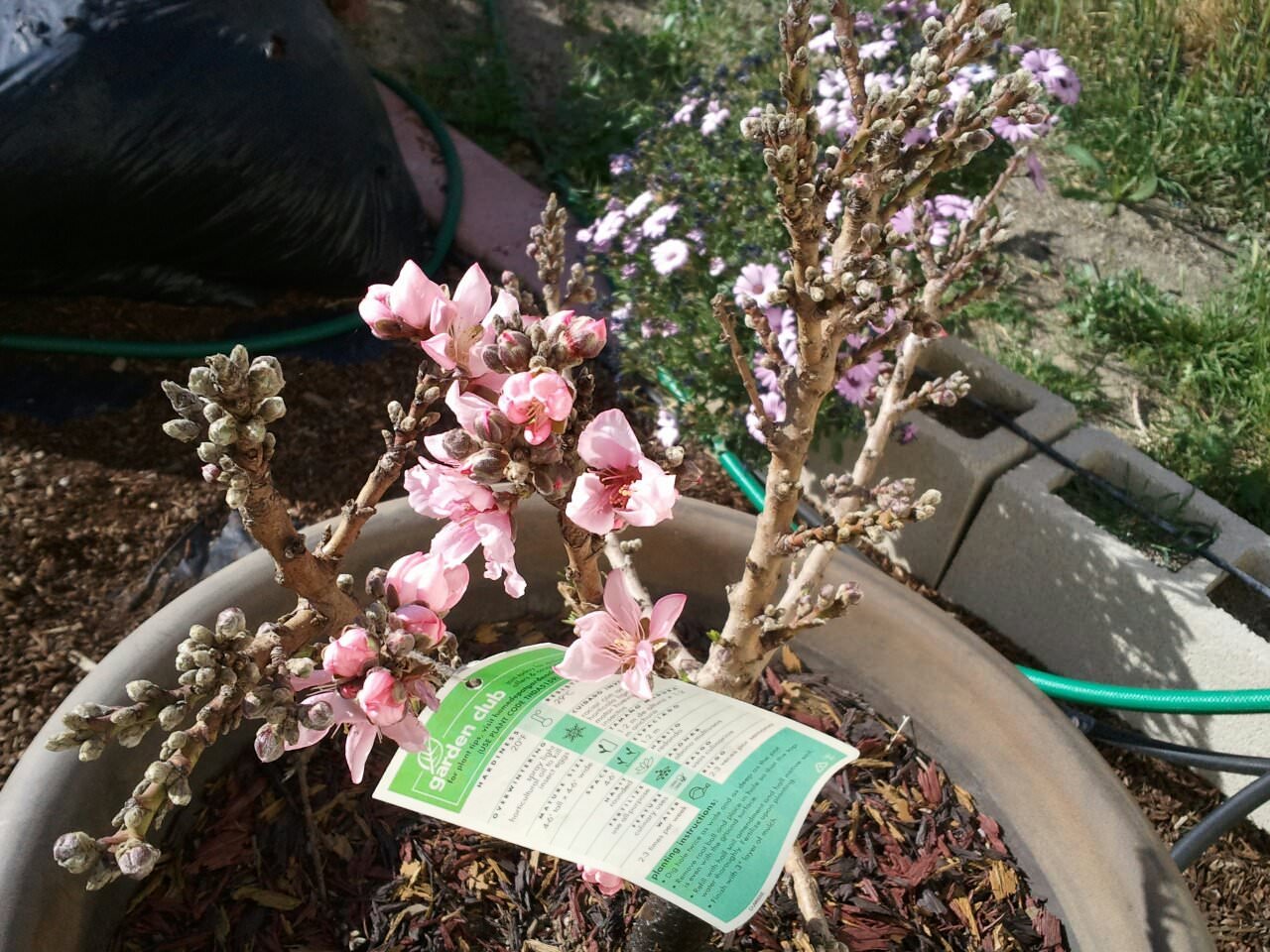
More of the flowers blooming. Absolutely gorgeous.

Leaves coming in nicely with the remaining flowers blooming as the first flowers began dying off.

There were a few peaches which started to grow but none of them made it. It was disappointing but not unexpected, as this tree was a few years too early to be producing fruit, anyway.
THE ORCHARD TAUGHT ME THE IMPORTANCE OF NOT OVERWATERING, STRATEGIES TO DIAGNOSE AND TREAT PROBLEMS BY READING THE PLANTS, HOW TO CARE FOR CITRUS TREES, AND HOW FIRST FRUITS CAN CAUSE A TREE TO PUT ALL OF IT'S ENERGY INTO THAT ONE FRUIT, NOT LEAVING ENOUGH JUICE FOR THE OTHER FRUIT, CAUSING THEM TO TAKE FOREVER GROWING AND RIPENING, IF THEY EVEN DO.
ONCE AGAIN, HERE IS THE DESIGN I TRANSLATED INTO A C.A.D. DRAWING
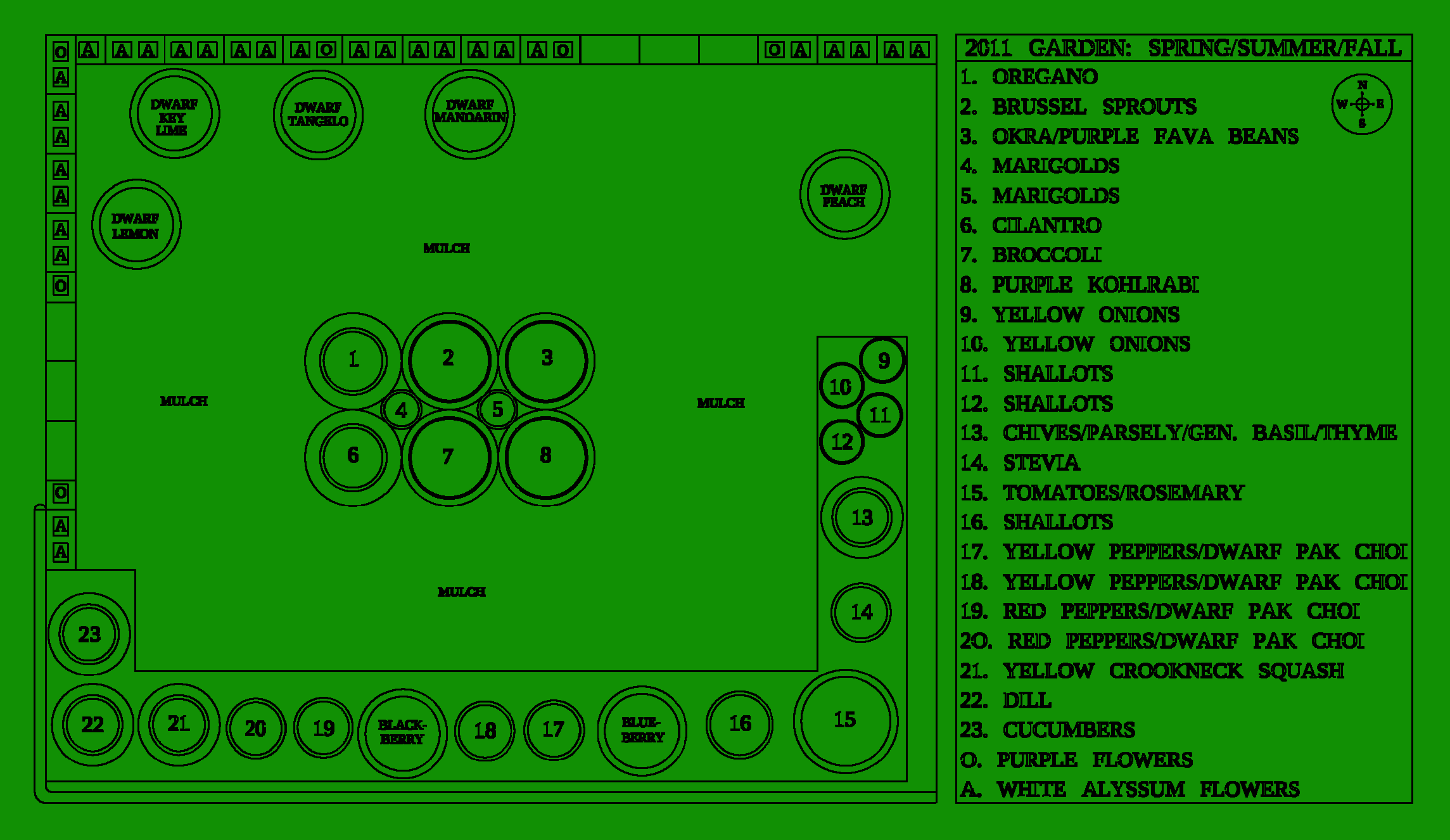
For reference, here are the previous posts:
STORIES:
BAREFOOT IN THE BOONIES: EXPOSING MY ROOTS (introduction post)
BAREFOOT IN THE BOONIES: Chapter 1
BAREFOOT IN THE BOONIES: FAMILY OWNED: Chapter 1 Section 2
2011 GARDEN:
2011: DESIGN AND BUILD
2011 BACKYARD TRELLIS, PERIMETER, & VOLUNTEER
2011 TIRE PORTION OF THE GARDEN
2011 BRASSICAS-TIRE GARDEN
TO BE CONTINUED...

That's all for now. Until the next post... If you found this post enjoyable, please consider upvoting, resteeming, following, and commenting! Thank you kindly for reading.

(Created by @bembelmaniac)


(Created by @soulturtle)

So come say hello in the following Discord chat rooms:


